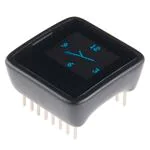General Overview of MicroView
Intro
General Overview of MicroView
by JP Liew
The MicroView is the first chip-sized Arduino compatible that lets you see what your Arduino is thinking
by using a built-in OLED display. In the heart of MicroView there is an ATMEL’s ATmega328P, 5V & 3.3V
LDO and a 64x48 pixel OLED display, together with other passive components that allow the MicroView
to operate without any external components other than a power supply.
MicroView is 100% code compatible with Arduino Uno (ATmega328P version), meaning the
code that runs on an Arduino Uno will also be able to run on the MicroView if the IO pins
used in the code are externally exposed on the MicroView.
Hardware Specifications
• Display : 64x48 OLED Display
• Microcontroller : ATmega328P
• Operating Voltage : 5V
• Input Voltage : 3.3VDC - 16VDC
• Digital I/O Pins : 12 (of which 3 provide PWM output)
• Analog Input Pins : 6
• Flash Memory : 32 KB
• SRAM : 2 KB
• EEPROM : 1 Kilobyte
• Clock Speed : 16 Mhz
• No other components required
Pin Configuration
�For more details on pins of MicroView, please refer to the ATmega328P Datasheet.
OLED Memory Map
The SSD1306 is the controller built into the MicroView’s OLED display. It has flexible yet complex
segment and common drivers. One requires vast knowledge on memory addressing in order to use the
SSD1306 controller.
MicroView’s library was written to hide away the complexities of the SSD1306 controller, so that users
can issue simple commands to control the display. Although the SSD1306 has a built-in RAM (memory)
for the screen, when connected using the SPI method, the ATmega328P is not able to read the RAM
(memory) of the SSD1306. Therefore the software will not be able to manipulate the screen buffer to
perform mathematical operations.
MicroView’s library overcomes this by allocating 384 bytes ( (64 x 48)/8 bits) of memory from
ATmega328P as buffer. The library can now manipulate the screen buffer and then perform a bulk
transfer from the ATmega328P’s memory to the internal memory of the SSD1306 controller.
The 384 bytes of screen buffer are declared in MicroView’s library as
static uint8_t screenmemory [] = {.total 384 bytes of data..};
and are arranged in a linear form representing the following 64 x 48 pixels coordinate system.
�Based on the above illustration, for example, if a user wish to plot a pixel at the position of the black dot,
where X=10 and Y=2, the would user issue the following command:
uView.pixel(10,2);
This command will then calculate the exact location of the screen buffer and set a BIT in the
corresponding BYTE to the X,Y position.
Diagram showing how a linear screen buffer in the ATmega328P aligns with the OLED pixels.
�Diagram showing the BITs in a BYTE of the screen buffer corresponding to the OLED’s X,Y position.
Based on the above illustration, a pixel turned on at X=2 and Y=3 means BYTE 2 of the screen buffer has
data of 0x08 (hex).
Two pixels at X=2,Y=3 and X=2,Y=2 turned on means BYTE 2 of the screen buffer has data of 0x0c (hex).
To draw a straight line of 5 pixels starting from 10,2 to 10,6 , the following C code show a pixel by pixel
way on how to accomplish this:
uView.pixel(10,2);
uView.pixel(10,3);
uView.pixel(10,4);
uView.pixel(10,5);
uView.pixel(10,6);
the MicroView library allows you to draw lines by specifying the the start and end coordinates. The above
line could be drawn with this simple one line command:
uView.line(10,2,10,6);
In order for the library to perform extremely fast mathematical operations on the screen buffer (more
than 100 frames per second), calls to the drawing functions within the MicroView library does not
immediately transfer the contents of screen buffer to the SSD1306 controller. A display() command
is required to instruct the library to perform the bulk transfer from the screen buffer to the SSD1306
controller:
uView.display();
This function takes the whole screen buffer in the ATmega328P and transfers it (via SPI bus,
programmed at 8Mhz) to the internal memory of the SSD1306. As soon as the memory is being
transferred, the pixels corresponding to the screen buffer will show up on the OLED display.
Published 04 June 2014
microview
ssd1306
introduction
overview
memory map
screen buffer
http://learn.microview.io/intro/general-overview-of-microview.html
4/16/2015
�
很抱歉,暂时无法提供与“DEV-12923”相匹配的价格&库存,您可以联系我们找货
免费人工找货